Retrieval of Ocean Surface Currents by Synergistic Sentinel-1 and SWOT Data Using Deep Learning
Abstract
1. Introduction
2. Study Area and Datasets
2.1. Study Area
2.2. Datasets
2.2.1. S1 OCN Data
2.2.2. ECMWF ERA5 Reanalysis Data
2.2.3. SWOT L3 Data
3. Methodology
3.1. S1 RVL Data Preprocessing
3.2. Dataset Construction
3.3. Model Development
3.3.1. Architecture of the Model
3.3.2. Experimental Setup and Evaluation Metrics
4. Results
4.1. OSC Retrieval Results
4.2. Ablation Study
4.2.1. Evaluating the Impact of Input Parameters
4.2.2. Evaluating the Impact of ResNet
4.3. Model Comparison
4.4. Case Studies
4.4.1. Retrieval of the Gulf Stream Using OSCNet
4.4.2. Mesoscale Eddies in OSCNet-Retrieved OSC RVL
5. Discussion
6. Conclusions
Author Contributions
Funding
Data Availability Statement
Acknowledgments
Conflicts of Interest
References
- Villas Bôas, A.B.; Ardhuin, F.; Ayet, A.; Bourassa, M.A.; Brandt, P.; Chapron, B.; Cornuelle, B.D.; Farrar, J.T.; Fewings, M.R.; Fox-Kemper, B.; et al. Integrated Observations of Global Surface Winds, Currents, And Waves: Requirements And Challenges for the Next Decade. Front. Mar. Sci. 2019, 6, 425. [Google Scholar] [CrossRef]
- Hauser, D.; Abdalla, S.; Ardhuin, F.; Bidlot, J.-R.; Bourassa, M.; Cotton, D.; Gommenginger, C.; Evers-King, H.; Johnsen, H.; Knaff, J. Satellite Remote Sensing of Surface Winds, Waves, And Currents: Where Are We Now? Surv. Geophys. 2023, 44, 1357–1446. [Google Scholar] [CrossRef]
- Yang, L.; Chen, G.; Zhao, J.; Rytter, N.G.M. Ship Speed Optimization Considering Ocean Currents to Enhance Environmental Sustainability in Maritime Shipping. Sustainability 2020, 12, 3649. [Google Scholar] [CrossRef]
- Klemas, V. Remote Sensing of Coastal And Ocean Currents: An Overview. J. Coast. Res. 2012, 28, 576. [Google Scholar]
- Futch, V.; Allen, A. Search And Rescue Applications: On the Need to Improve Ocean Observing Data Systems in Offshore Or Remote Locations. Front. Mar. Sci. 2019, 6, 301. [Google Scholar] [CrossRef]
- Goldstein, R.M.; Zebker, H. Interferometric Radar Measurement of Ocean Surface Currents. Nature 1987, 328, 707–709. [Google Scholar] [CrossRef]
- Shuchman, R.; Rufenach, C.; Gonzalez, F.; Klooster, A. The Feasibility of Measurement of Ocean Current Detection Using SAR Data. In Proceedings of the 13th International Symposium on Remote Sensing of Environment, Ann Arbor, MI, USA, 23–27 April 1979; pp. 93–103. [Google Scholar]
- Romeiser, R.; Runge, H.; Suchandt, S.; Kahle, R.; Rossi, C.; Bell, P.S. Quality Assessment of Surface Current Fields from TerraSAR-X and TanDEM-X Along-Track Interferometry And Doppler Centroid Analysis. IEEE Trans. Geosci. Remote Sens. 2014, 52, 2759–2772. [Google Scholar] [CrossRef]
- Du, Y.; Shao, J.; Yang, X.; Wang, R.; Yang, J.; Li, X. Investigation of Current-Wave Interaction Effect on Ocean Surface Current Retrieval under DCA Framework Using An Improved Doppler Radar Imaging Model. IEEE Trans. Geosci. Remote Sens. 2024, 62, 4213217. [Google Scholar] [CrossRef]
- Hansen, M.W.; Collard, F.; Dagestad, K.-F.; Johannessen, J.A.; Fabry, P.; Chapron, B. Retrieval of Sea Surface Range Velocities from ENVISAT ASAR Doppler Centroid Measurements. IEEE Trans. Geosci. Remote Sens. 2011, 49, 3582–3592. [Google Scholar] [CrossRef]
- Hansen, M.W.; Johannessen, J.; Dagestad, K.-F.; Collard, F.; Chapron, B. Monitoring the Surface Inflow of Atlantic Water to the Norwegian Sea Using ENVISAT ASAR. J. Geophys. Res. 2011, 116, C12008. [Google Scholar] [CrossRef]
- Rouault, M.J.; Mouche, A.; Collard, F.; Johannessen, J.A.; Chapron, B. Mapping the Agulhas Current from Space: An Assessment of ASAR Surface Current Velocities. J. Geophys. Res. 2010, 115, C10026. [Google Scholar]
- Fan, S.; Zhang, B.; Kudryavtsev, V.; Perrie, W. Mapping Radial Ocean Surface Currents in the Outer Core of Hurricane Maria from Synthetic Aperture Radar Doppler Measurements. IEEE J. Sel. Top. Appl. Earth Obs. Remote Sens. 2024, 17, 2090–2097. [Google Scholar] [CrossRef]
- Yang, Z.; Liu, L.; Wang, J.; Miao, H.; Zhang, Q. Extrapolation of Electromagnetic Pointing Error Corrections for Sentinel-1 Doppler Currents from Land Areas to the Open Ocean. Remote Sens. Environ. 2023, 297, 113788. [Google Scholar] [CrossRef]
- Yang, X.; He, Y. Retrieval of A Real-Time Sea Surface Vector Field from SAR Doppler Centroid: 2. On the Radial Velocity. J. Geophys. Res. 2023, 125, e2022JC019301. [Google Scholar] [CrossRef]
- Fan, S.; Zhang, B.; Moiseev, A.; Kudryavtsev, V.; Johannessen, J.A.; Chapron, B. On the Use of Dual Co-Polarized Radar Data to Derive A Sea Surface Doppler Model-Part 2: Simulation and Validation. IEEE Trans. Geosci. Remote Sens. 2023, 61, 4202009. [Google Scholar] [CrossRef]
- Sun, K.; Chong, J.; Diao, L.; Li, Z.; Wei, X. On the Use of Ocean Surface Doppler Velocity for Oceanic Front Extraction from Chinese Gaofen-3 SAR Data. IEEE J. Sel. Top. Appl. Earth Obs. Remote Sens. 2022, 15, 2709–2720. [Google Scholar] [CrossRef]
- Sun, K.; Diao, L.; Zhao, Y.; Zhao, W.; Xu, Y.; Chong, J. Impact of SAR Azimuth Ambiguities on Doppler Velocity Estimation Performance: Modeling And Analysis. Remote Sens. 2023, 15, 1198. [Google Scholar] [CrossRef]
- Li, Y.; Chong, J.; Sun, K.; Zhao, Y.; Yang, X. Measuring Ocean Surface Current in the Kuroshio Region Using Gaofen-3 SAR Data. Appl. Sci. 2021, 11, 7656. [Google Scholar] [CrossRef]
- Chapron, B. Direct Measurements of Ocean Surface Velocity from Space: Interpretation And Validation. J. Geophys. Res. 2005, 110, C07008. [Google Scholar] [CrossRef]
- Moiseev, A.; Johnsen, H.; Johannessen, J.A.; Collard, F.; Guitton, G. On Removal of Sea State Contribution to Sentinel-1 Doppler Shift for Retrieving Reliable Ocean Surface Current. J. Geophys. Res. 2020, 125, e2020JC016288. [Google Scholar] [CrossRef]
- Mouche, A.A.; Collard, F.; Chapron, B.; Dagestad, K.-F.; Guitton, G.; Johannessen, J.A.; Kerbaol, V.; Hansen, M.W. On the Use of Doppler Shift for Sea Surface Wind Retrieval from SAR. IEEE Trans. Geosci. Remote Sens. 2012, 50, 2901–2909. [Google Scholar] [CrossRef]
- Moiseev, A.; Johannessen, J.A.; Johnsen, H. Towards Retrieving Reliable Ocean Surface Currents in the Coastal Zone from the Sentinel-1 Doppler Shift Observations. J. Geophys. Res. 2022, 127, e2021JC018201. [Google Scholar] [CrossRef]
- Ardhuin, F.; Gille, S.T.; Menemenlis, D.; Rocha, C.B.; Rascle, N.; Chapron, B.; Gula, J.; Molemaker, J. Small-Scale Open Ocean Currents Have Large Effects on Wind Wave Heights. J. Geophys. Res. 2017, 122, 4500–4517. [Google Scholar] [CrossRef]
- Kudryavtsev, V.; Yurovskaya, M.; Chapron, B.; Collard, F.; Donlon, C. Sun Glitter Imagery of Surface Waves. Part 2: Waves Transformation on Ocean Currents. J. Geophys. Res. 2017, 122, 1384–1399. [Google Scholar] [CrossRef]
- Wang, H.; Li, X. DeepBlue: Advanced Convolutional Neural Network Applications for Ocean Remote Sensing. IEEE Trans. Geosci. Remote Sens. 2024, 12, 138–161. [Google Scholar] [CrossRef]
- Ristea, N.-C.; Anghel, A.; Datcu, M.; Chapron, B. Guided Unsupervised Learning by Subaperture Decomposition for Ocean SAR Image Retrieval. IEEE Trans. Geosci. Remote Sens. 2023, 61, 5207111. [Google Scholar] [CrossRef]
- Zi, N.; Li, X.-M.; Gade, M.; Fu, H.; Min, S. Ocean Eddy Detection Based on YOLO Deep Learning Algorithm by Synthetic Aperture Radar Data. Remote Sens. Environ. 2024, 307, 114139. [Google Scholar] [CrossRef]
- Zhang, S.; Li, X.; Zhang, X. Internal Wave Signature Extraction from SAR and Optical Satellite Imagery Based on Deep Learning. IEEE Trans. Geosci. Remote Sens. 2023, 61, 4203216. [Google Scholar] [CrossRef]
- Zhang, X.; Wang, H.; Wang, S.; Liu, Y.; Yu, W.; Wang, J.; Xu, Q.; Li, X. Oceanic Internal Wave Amplitude Retrieval from Satellite Images Based on a Data-Driven Transfer Learning Model. Remote Sens. Environ. 2022, 272, 112940. [Google Scholar] [CrossRef]
- Wu, K.; Li, X.-M. Deep Learning for Retrieving Omni-Directional Ocean Wave Spectra from Spaceborne Synthetic Aperture Radar. Remote Sens. Environ. 2024, 314, 114386. [Google Scholar] [CrossRef]
- Zhou, Y.; Shao, W.; Nunziata, F.; Wang, W.; Li, C. An Algorithm to Retrieve Range Ocean Current Speed under Tropical Cyclone Conditions from Sentinel-1 Synthetic Aperture Radar Measurements Based on XGBoost. Remote Sens. 2024, 16, 3271. [Google Scholar] [CrossRef]
- Yang, Z.; Wang, J.; Liu, L.; Miao, H.; Miao, X.; Zhang, Q. Estimating Effects of Wind And Waves on the Doppler Centroid Frequency Shift for the SAR Retrieval of Ocean Currents. Remote Sens. Environ. 2024, 311, 114312. [Google Scholar] [CrossRef]
- Shao, W.; Zhou, Y.; Hu, Y.; Li, Y.; Zhou, Y.; Zhang, Q. Range Current Retrieval from Sentinel-1 SAR Ocean Product Based on Deep Learning. Remote Sens. Lett. 2024, 15, 145–156. [Google Scholar] [CrossRef]
- Bai, Y.; Zhang, Y.; Zhang, X.; Li, X. A Machine-Learning-Based Ocean-Current Velocity Inversion Model Using OCN from Sentinel-1 Observations. IEEE J. Sel. Top. Appl. Earth Obs. Remote Sens. 2025, 18, 9622–9635. [Google Scholar] [CrossRef]
- Morrow, R.; Fu, L.-L.; Ardhuin, F.; Benkiran, M.; Chapron, B.; Cosme, E.; d’Ovidio, F.; Farrar, J.T.; Gille, S.T.; Lapeyre, G.; et al. Global Observations of Fine-Scale Ocean Surface Topography with the Surface Water And Ocean Topography (SWOT) Mission. Front. Mar. Sci. 2019, 6, 232. [Google Scholar] [CrossRef]
- Peral, E.; Esteban-Fernández, D.; Rodríguez, E.; McWatters, D.; De Bleser, J.-W.; Ahmed, R.; Chen, A.C.; Slimko, E.; Somawardhana, R.; Knarr, K.; et al. KARIN, the Ka-Band Radar Interferometer of the SWOT Mission: Design and In-Flight Performance. IEEE Trans. Geosci. Remote Sens. 2024, 62, 5214127. [Google Scholar] [CrossRef]
- Barcelô-Llull, B.; Pascual, A.; Sánchez-Román, A.; Cutolo, E.; d’Ovidio, F.; Fifani, G.; Ser-Giacomi, E.; Ruiz, S.; Mason, E.; Cyr, F. Fine-Scale Ocean Currents Derived from in Situ Observations in Anticipation of the Upcoming SWOT Altimetric Mission. Front. Mar. Sci. 2021, 8, 679844. [Google Scholar] [CrossRef]
- Holthuijsen, L.; Tolman, H. Effects of the Gulf Stream on Ocean Waves. J. Geophys. Res. 1991, 96, 12755–12771. [Google Scholar] [CrossRef]
- Hayes, J.G. Ocean Current Wave Interaction Study. J. Geophys. Res. 1980, 85, 5025–5031. [Google Scholar] [CrossRef]
- Allahdadi, M.N.; He, R.; Neary, V.S. Impact of the Gulf Stream on Ocean Waves. Deep Sea Res. Part II 2023, 208, 105239. [Google Scholar] [CrossRef]
- He, K.; Zhang, X.; Ren, S.; Sun, J. Deep residual learning for image recognition. In Proceedings of the 2016 IEEE Conference on Computer Vision and Pattern Recognition (CVPR), Las Vegas, NV, USA, 27–30 June 2016; pp. 770–778. [Google Scholar]

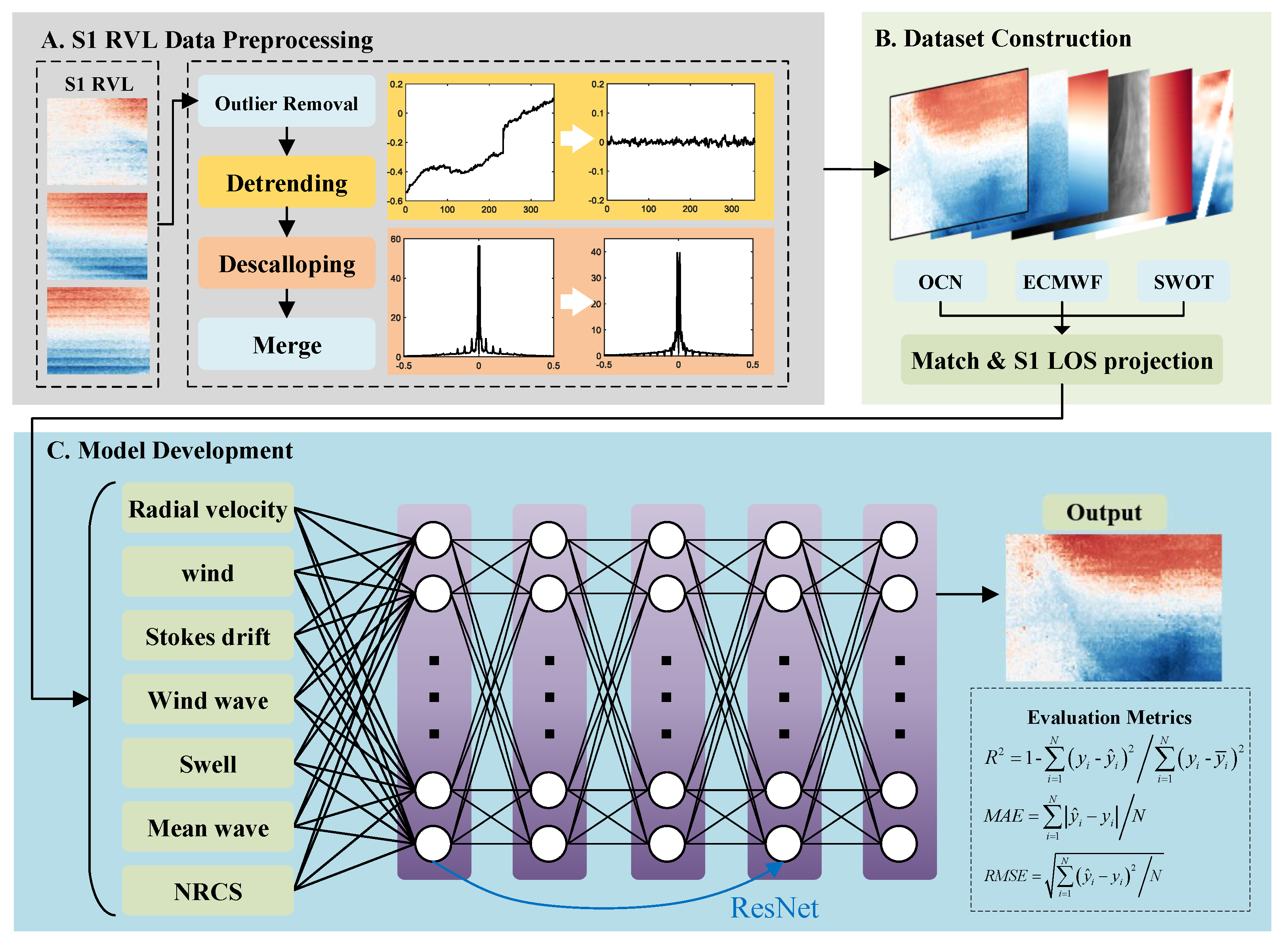
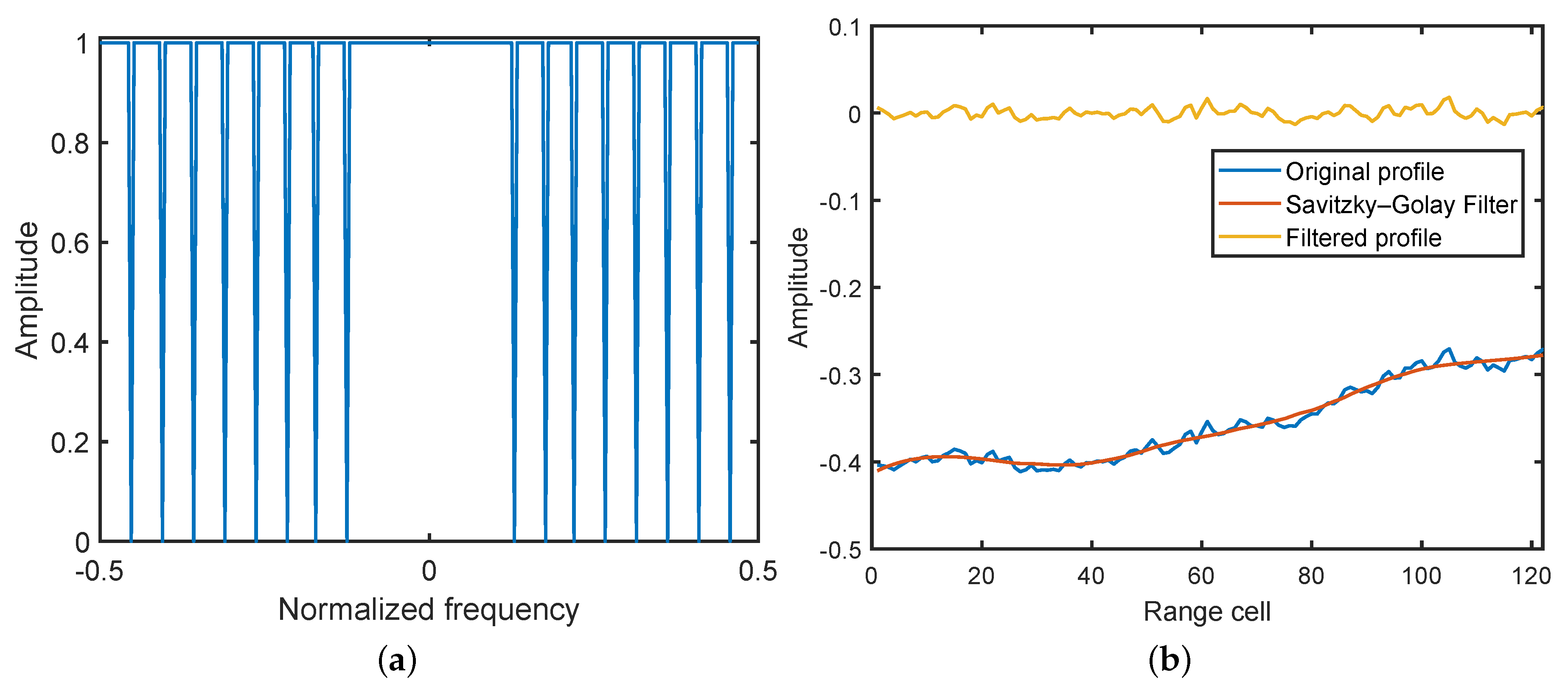
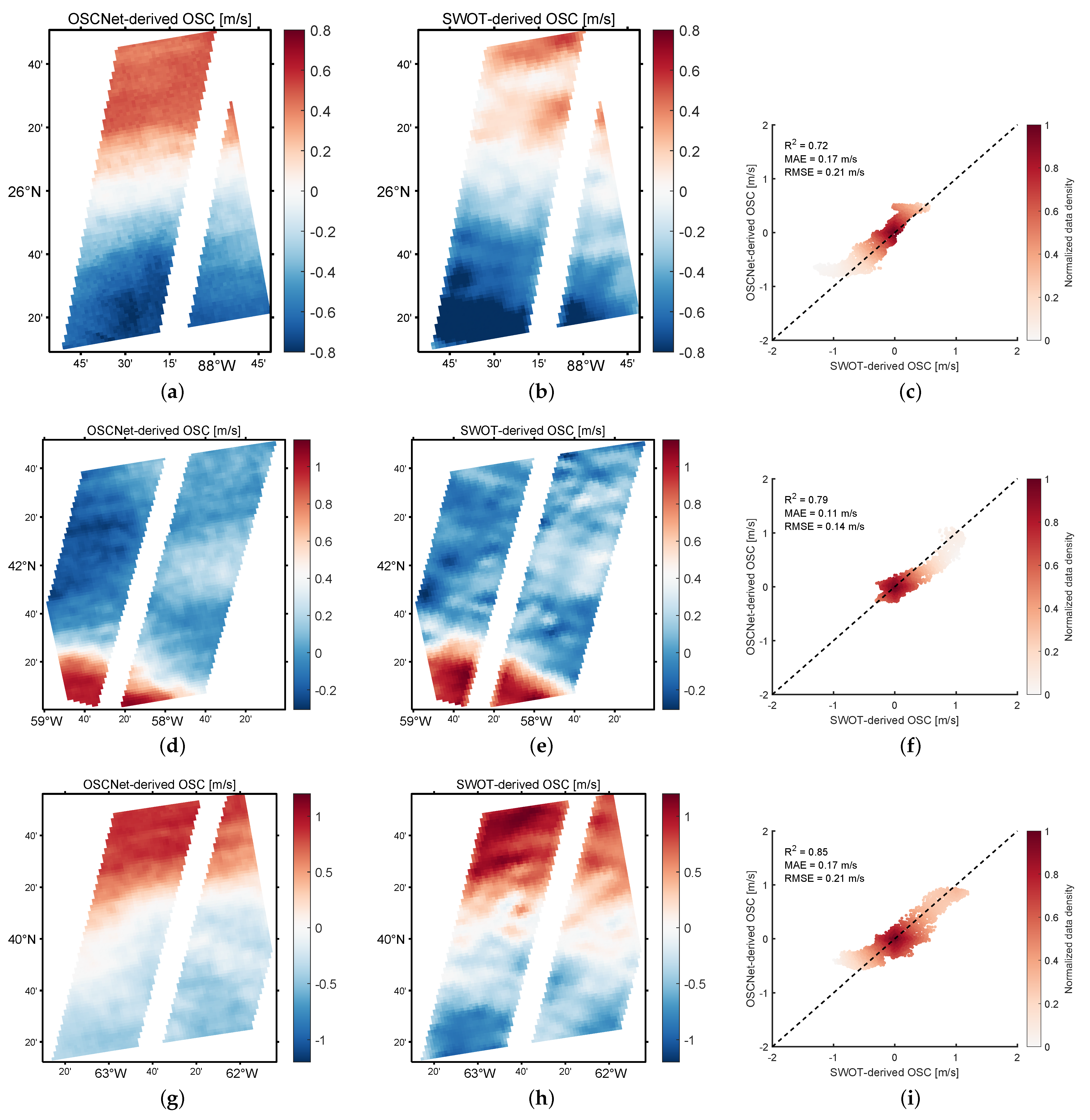

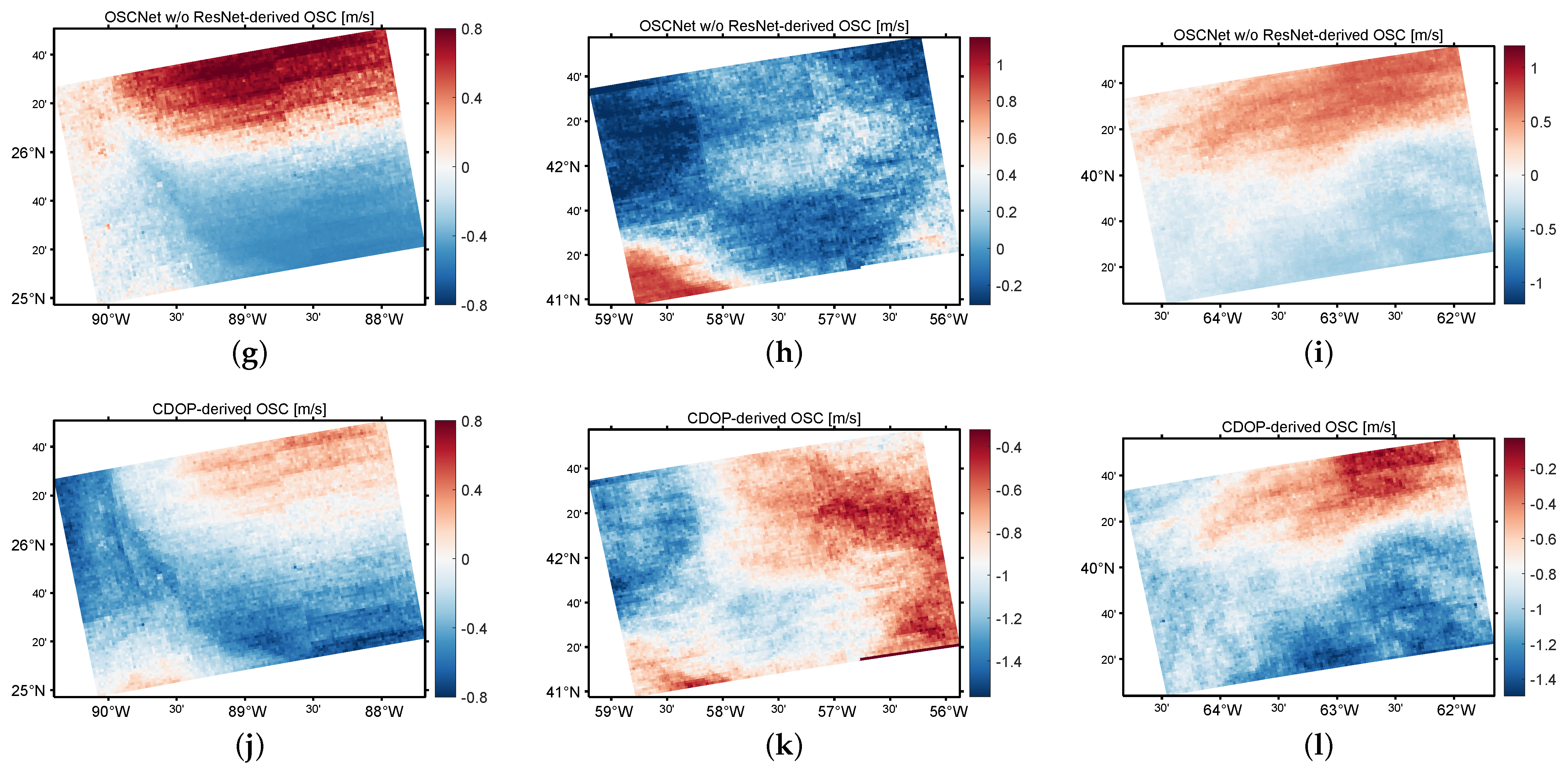
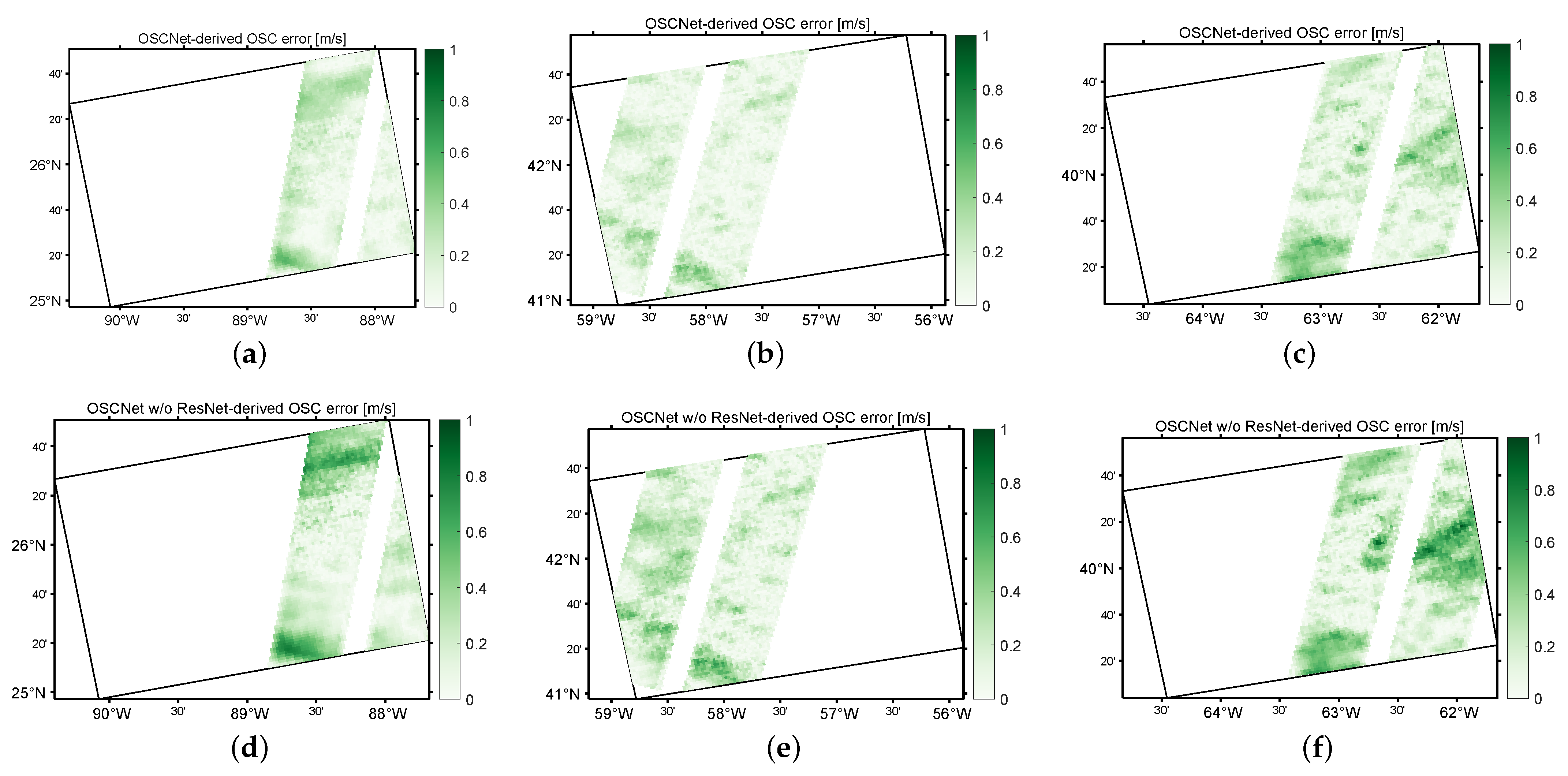

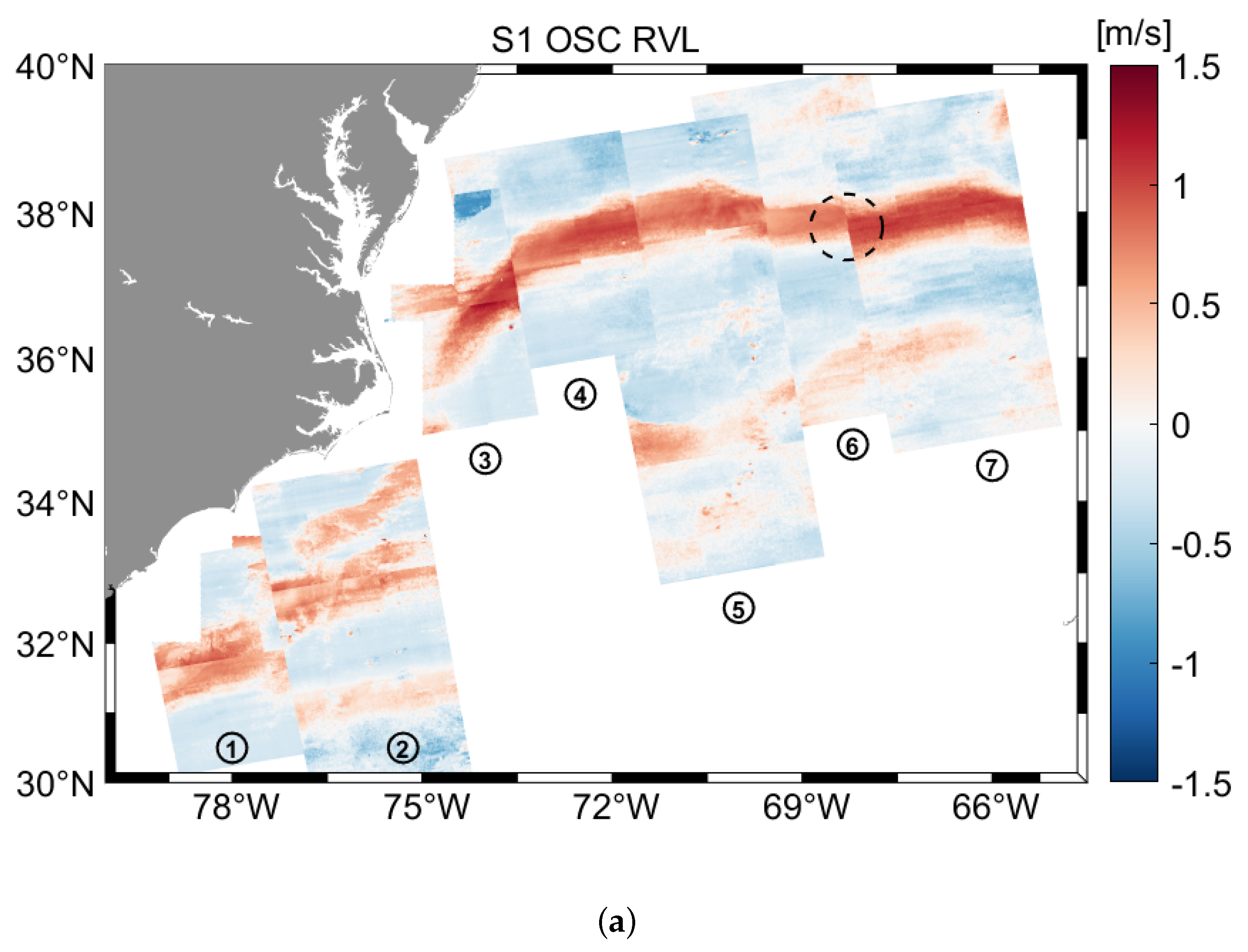
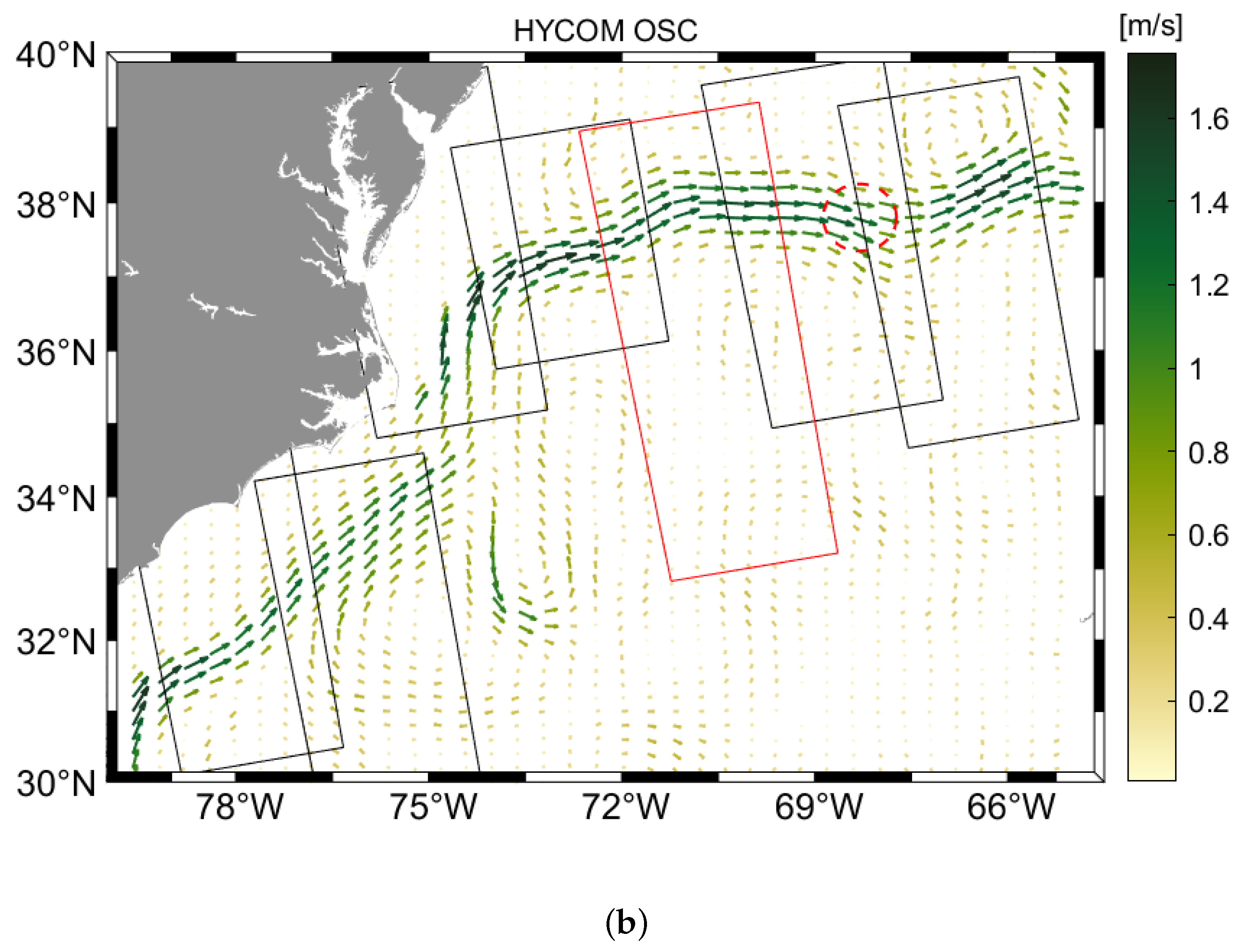
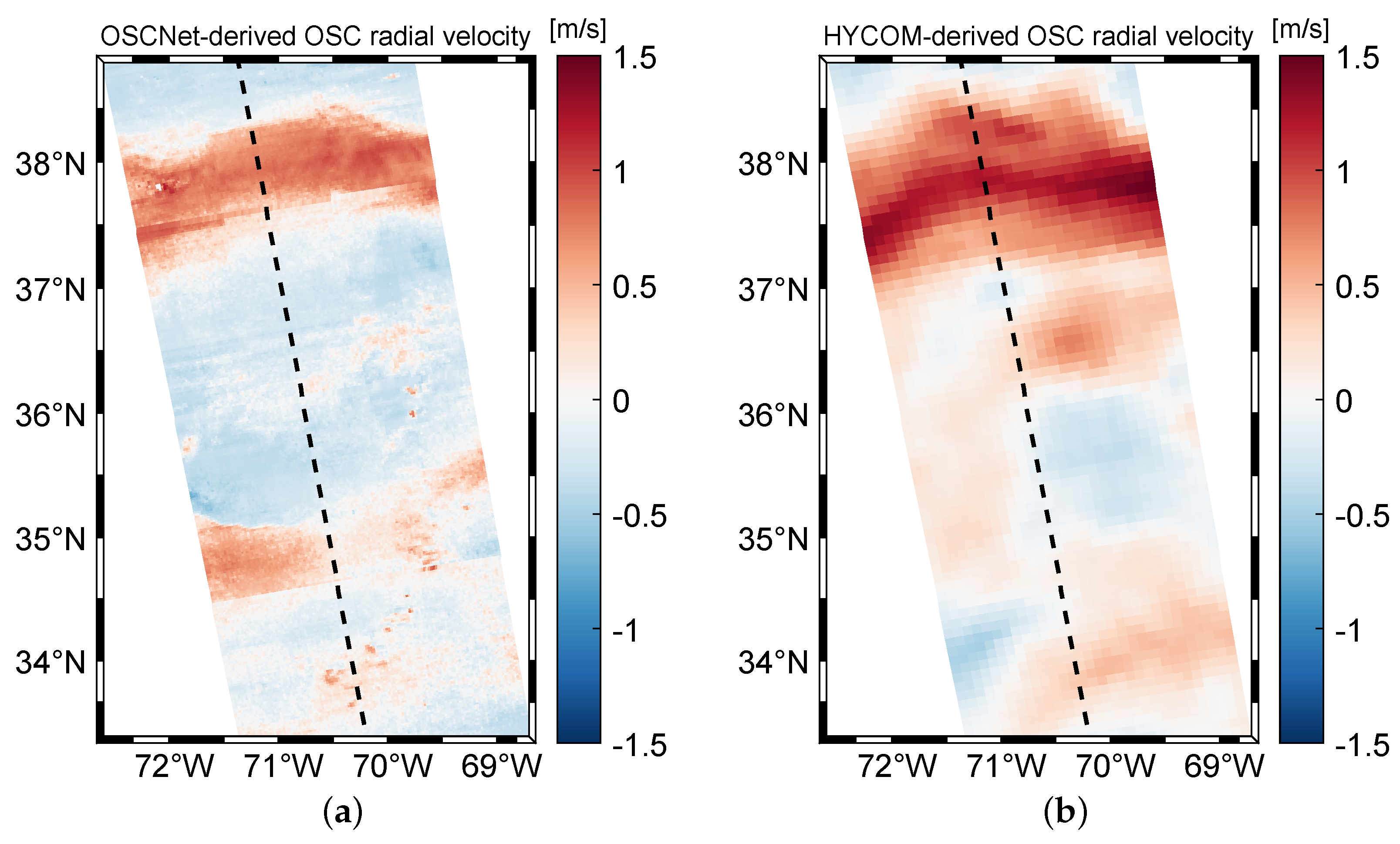
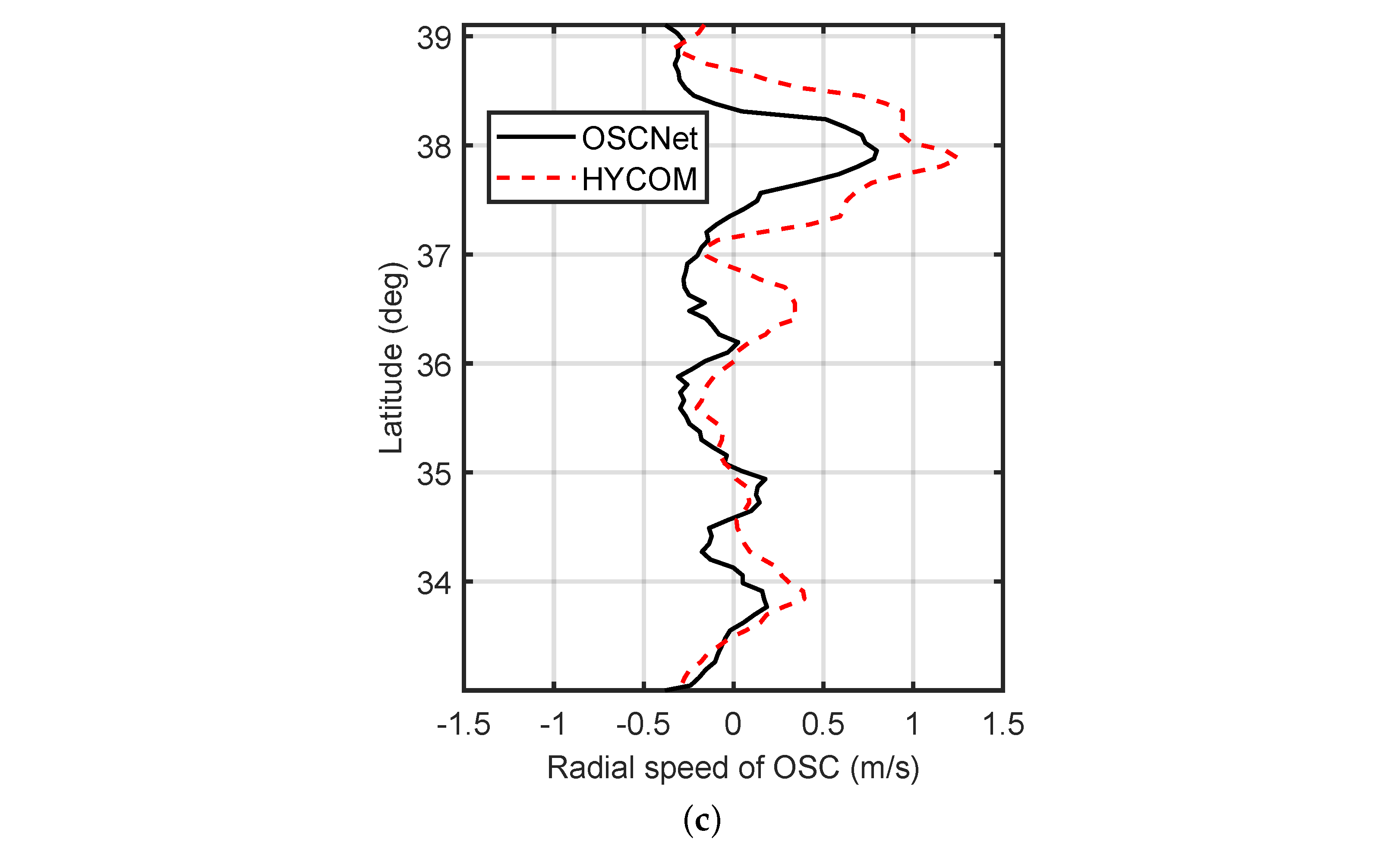
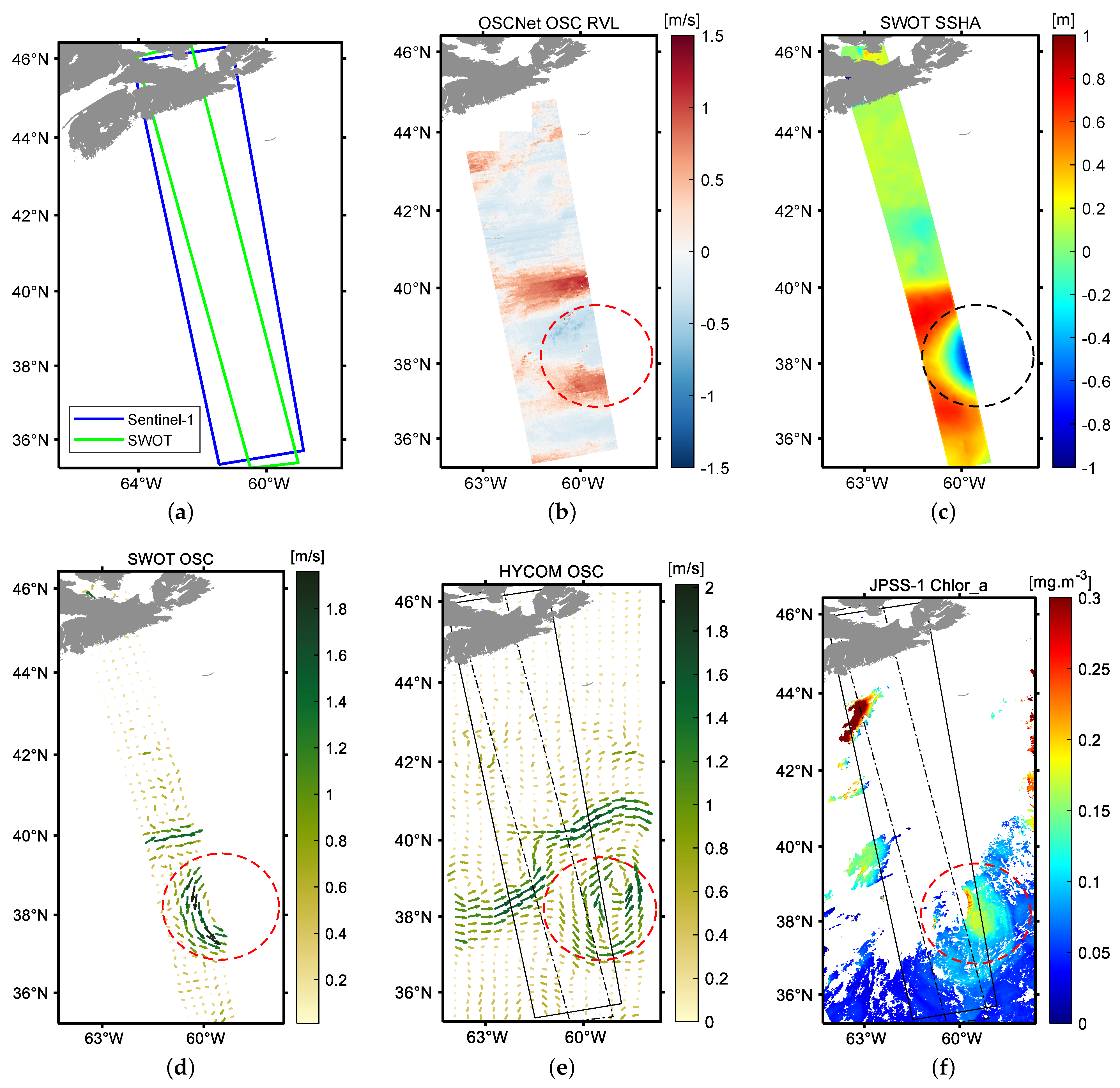
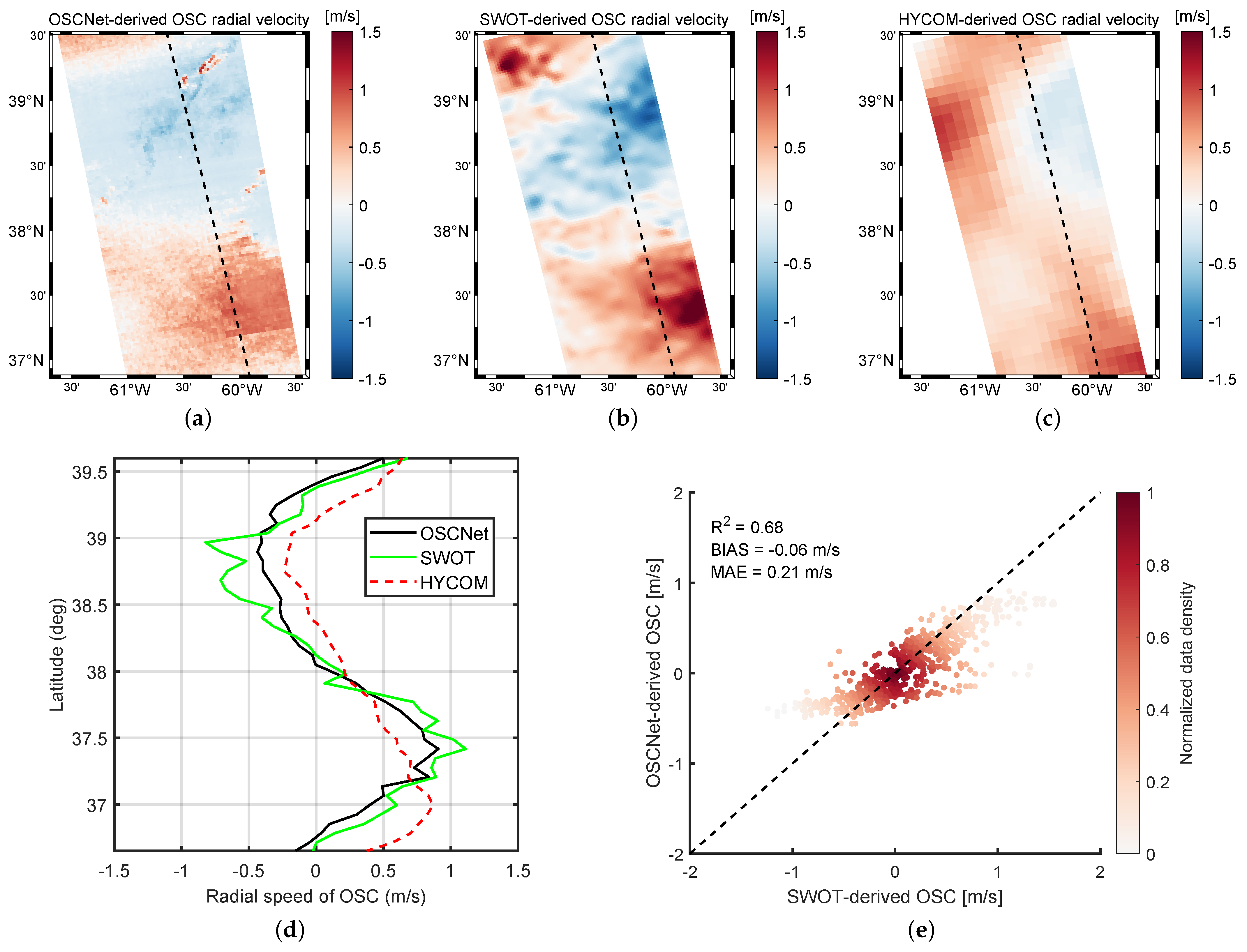
| Data Source | Data Set (Unit) | Resolution | Swath | Data Provider |
|---|---|---|---|---|
| S1 IW OCN | Surface radial velocity (m/s), wind speed (m/s), Stokes drift (m/s), platform heading (deg) | 1 km | 300 km | ESA/Copernicus |
| ERA5 Reanalysis | Significant height (m), mean period (s), and mean direction (deg) of wind waves; total swells and mean waves | 0.25° | – | ECMWF |
| SWOT L3 | Geostrophic currents (m/s) | 2 km | 128 km | AVISO/DUACS |
| Model | Input Parameters | Evaluation Metrics | ||||||||
|---|---|---|---|---|---|---|---|---|---|---|
| Radial Velocity | Wind | Stokes Drift | Wind Wave | Swell | Mean Wave | NRCS | MAE (m/s) | RMSE (m/s) | ||
| OSCNet | ✓ | ✓ | 0.75 | 0.18 | 0.23 | |||||
| ✓ | ✓ | ✓ | 0.78 | 0.17 | 0.21 | |||||
| ✓ | ✓ | ✓ | ✓ | 0.79 | 0.17 | 0.21 | ||||
| ✓ | ✓ | ✓ | ✓ | ✓ | 0.79 | 0.16 | 0.20 | |||
| ✓ | ✓ | ✓ | ✓ | ✓ | ✓ | 0.80 | 0.16 | 0.20 | ||
| ✓ | ✓ | ✓ | ✓ | ✓ | ✓ | ✓ | 0.81 | 0.15 | 0.19 | |
| OSCNet w/o ResNet | ✓ | ✓ | ✓ | ✓ | ✓ | ✓ | ✓ | 0.73 | 0.18 | 0.24 |
| CDOP | ✓ | 0.43 | 0.62 | 0.69 | ||||||
| No. | Acquisition Time | BIAS (m/s) | MAE (m/s) | RMSE (m/s) |
|---|---|---|---|---|
| 1 | 12 August 2023 | −0.18 | 0.26 | 0.29 |
| 2 | 19 August 2023 | −0.08 | 0.21 | 0.26 |
| 3 | 26 August 2023 | 0.11 | 0.22 | 0.25 |
| 4 | 9 August 2023 | −0.22 | 0.26 | 0.29 |
| 5 | 16 August 2023 | 0.14 | 0.22 | 0.26 |
| 6 | 11 August 2023 | 0.01 | 0.23 | 0.27 |
| 7 | 18 August 2023 | −0.21 | 0.24 | 0.28 |
Disclaimer/Publisher’s Note: The statements, opinions and data contained in all publications are solely those of the individual author(s) and contributor(s) and not of MDPI and/or the editor(s). MDPI and/or the editor(s) disclaim responsibility for any injury to people or property resulting from any ideas, methods, instructions or products referred to in the content. |
© 2025 by the authors. Licensee MDPI, Basel, Switzerland. This article is an open access article distributed under the terms and conditions of the Creative Commons Attribution (CC BY) license (https://creativecommons.org/licenses/by/4.0/).
Share and Cite
Sun, K.; Liang, J.; Li, X.-M.; Pan, J. Retrieval of Ocean Surface Currents by Synergistic Sentinel-1 and SWOT Data Using Deep Learning. Remote Sens. 2025, 17, 2133. https://doi.org/10.3390/rs17132133
Sun K, Liang J, Li X-M, Pan J. Retrieval of Ocean Surface Currents by Synergistic Sentinel-1 and SWOT Data Using Deep Learning. Remote Sensing. 2025; 17(13):2133. https://doi.org/10.3390/rs17132133
Chicago/Turabian StyleSun, Kai, Jianjun Liang, Xiao-Ming Li, and Jie Pan. 2025. "Retrieval of Ocean Surface Currents by Synergistic Sentinel-1 and SWOT Data Using Deep Learning" Remote Sensing 17, no. 13: 2133. https://doi.org/10.3390/rs17132133
APA StyleSun, K., Liang, J., Li, X.-M., & Pan, J. (2025). Retrieval of Ocean Surface Currents by Synergistic Sentinel-1 and SWOT Data Using Deep Learning. Remote Sensing, 17(13), 2133. https://doi.org/10.3390/rs17132133








